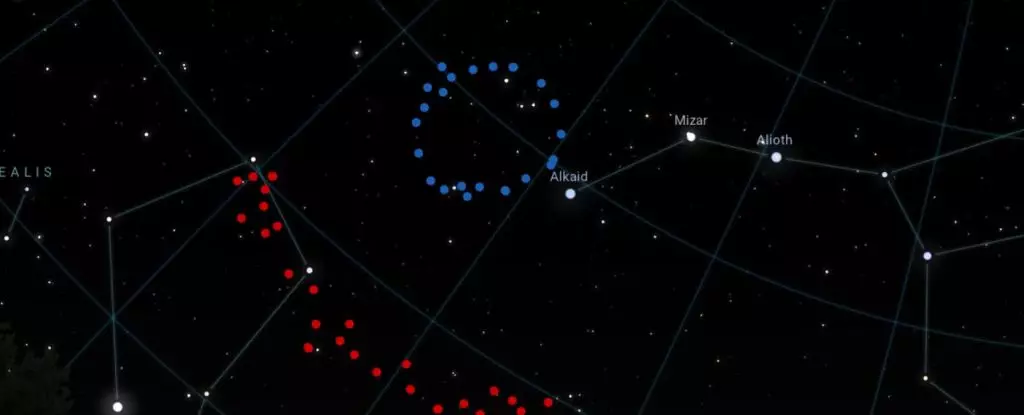In a groundbreaking revelation presented at the 243rd meeting of the American Astronomical Society, astronomers led by Alexia Lopez from the University of Central Lancashire unveiled a monumental cosmic structure dubbed the “Big Ring.” This colossal formation, comprising an almost flawless ring of galaxies, stretches a staggering 1.3 billion light-years in diameter and represents a significant anomaly in our current understanding of the Universe’s evolutionary timeline. Light from this structure has been traveling for an impressive 6.9 billion years to reach Earth, providing a unique glimpse into the cosmos long before the formation of our solar system.
The implications of such a discovery are profound, as it contradicts existing theories surrounding the formation and distribution of cosmic structures. Notably, the Big Ring bears no resemblance to any previously documented celestial formations, compelling astronomers to reconsider fundamental tenets of cosmology. The research indicates that we may need to revise the standard cosmological model, which has been long accepted as a guiding framework in understanding the vast Universe.
Connecting Cosmic Structures: The Giant Arc and Beyond
The revelation of the Big Ring is not an isolated event; it follows the discovery of the “Giant Arc,” another massive structure identified by Lopez and her team in the same vicinity of the sky. The Giant Arc, introduced to the scientific community in 2021, raised eyebrows due to its unique properties and dimensions. With the addition of the Big Ring, astronomers are faced with increasingly perplexing questions. As Lopez remarked, “Neither of these two ultra-large structures is easy to explain in our current understanding of the universe.”
The discovery of these structures not only challenges preconceived notions about cosmic arrangement but also invites scrutiny into the Cosmological Principle—an assumption stating that, at a macroscopic level, the Universe should exhibit uniformity across all regions. With both the Giant Arc and the Big Ring vastly exceeding the theoretically anticipated size limits of cosmic formations, astronomers are compelled to explore alternative explanations.
What is the Nature of the Big Ring?
Interestingly, the Big Ring does not fit into the category of Baryon Acoustic Oscillations (BAOs), which are massive spherical patterns of galaxies resulting from early Universe acoustic waves. Unlike the BAOs that typically measure around 1 billion light-years, the Big Ring presents an unusual corkscrew appearance that defies conventional classification. This discrepancy raises significant questions about its formation and structure.
Current cosmological models suggest that matter should be evenly distributed throughout the Universe, yet the existence of such large formations contradicts this idea. The established theoretical boundary for size limitations in cosmic structures is pegged at 1.2 billion light-years, making the size of the Big Ring and its counterpart perplexing anomalies. These structures could either signify fundamental flaws in our cosmological models or prompt a paradigm shift in our understanding of cosmic evolution.
The existence of these expansive structures forces researchers to consider alternative cosmological models, such as Roger Penrose’s conformal cyclic cosmology, which proposes that the Universe undergoes infinite cycles of expansion and contraction. In this model, ring-like structures are anticipated, yet it is crucial to note that this theory also grapples with its own set of challenges and inconsistencies.
Another intriguing possibility posits that the Big Ring and the Giant Arc may represent topological defects in the fabric of space-time known as cosmic strings. These theoretical constructs suggest that disturbances originating from the early Universe created “wrinkles” in space-time that became fixed. Although direct physical evidence for cosmic strings remains elusive, theoretical models continue to support their existence.
As astronomers embrace the reality of the Big Ring and its implications, they are faced with the challenge of accounting for its existence within the broader context of Milky Way observations and cosmic understanding. The possibility that these formations could merely be random aggregations of galaxies is diminishing, especially as researchers continue to unveil further formations of a similar scale.
As Lopez succinctly encapsulated, “From current cosmological theories, we didn’t think structures on this scale were possible.” The challenge lies in revising our perspectives on cosmic structure formation and distribution. Observations of further galaxy arrangements scattered throughout the Universe will be necessary to unlock the mysteries behind these monumental formations. The Big Ring and the Giant Arc not only challenge existing models but also present a tantalizing glimpse into the complexity of our Universe, potentially indicating that there is much more to discover amid the cosmic expanse.

